Exploring Resource Allocation & Service Provision in Aged Primary Care
VerifiedAdded on 2023/04/21
|8
|2014
|356
Essay
AI Summary
This essay examines primary healthcare for the aged, emphasizing the principles of curative, rehabilitative, palliative, preventive, and promotive care. It highlights the importance of regular health check-ups, access to healthcare professionals, and community health facilities. The essay underscores the significance of food safety programs, immunization, and safe water delivery in preventing chronic diseases among older adults. It also discusses multidisciplinary enablement programs, such as OPEN ARCH, for integrated care and early intervention. Resource allocation strategies, including equitable distribution and community participation, are explored to ensure adequate healthcare services for the elderly. The essay concludes by acknowledging the growing aging population and the challenges in healthcare service delivery, emphasizing the need for government efforts to develop active community care services and a skilled workforce for the aged.
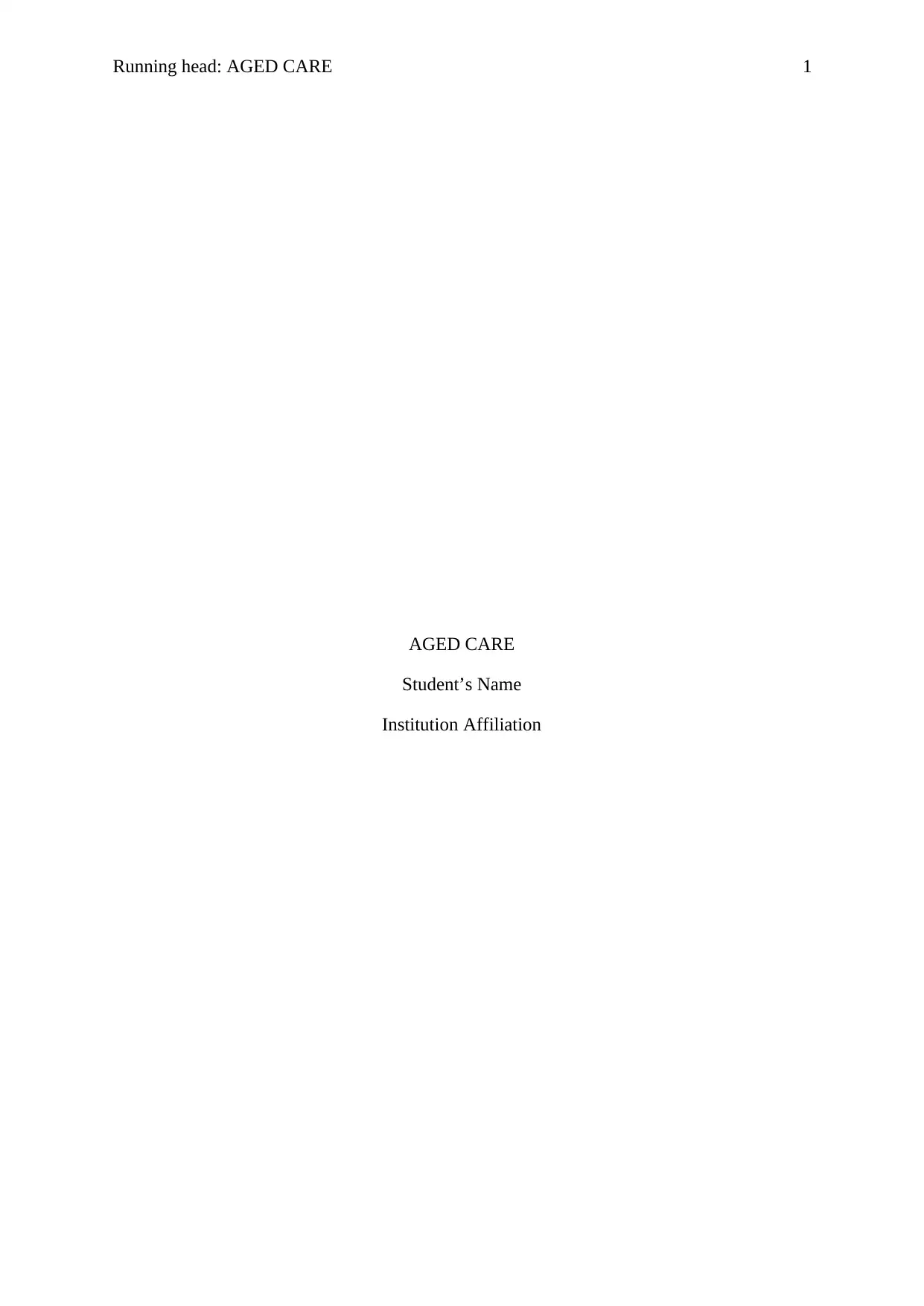
Running head: AGED CARE 1
AGED CARE
Student’s Name
Institution Affiliation
AGED CARE
Student’s Name
Institution Affiliation
Paraphrase This Document
Need a fresh take? Get an instant paraphrase of this document with our AI Paraphraser
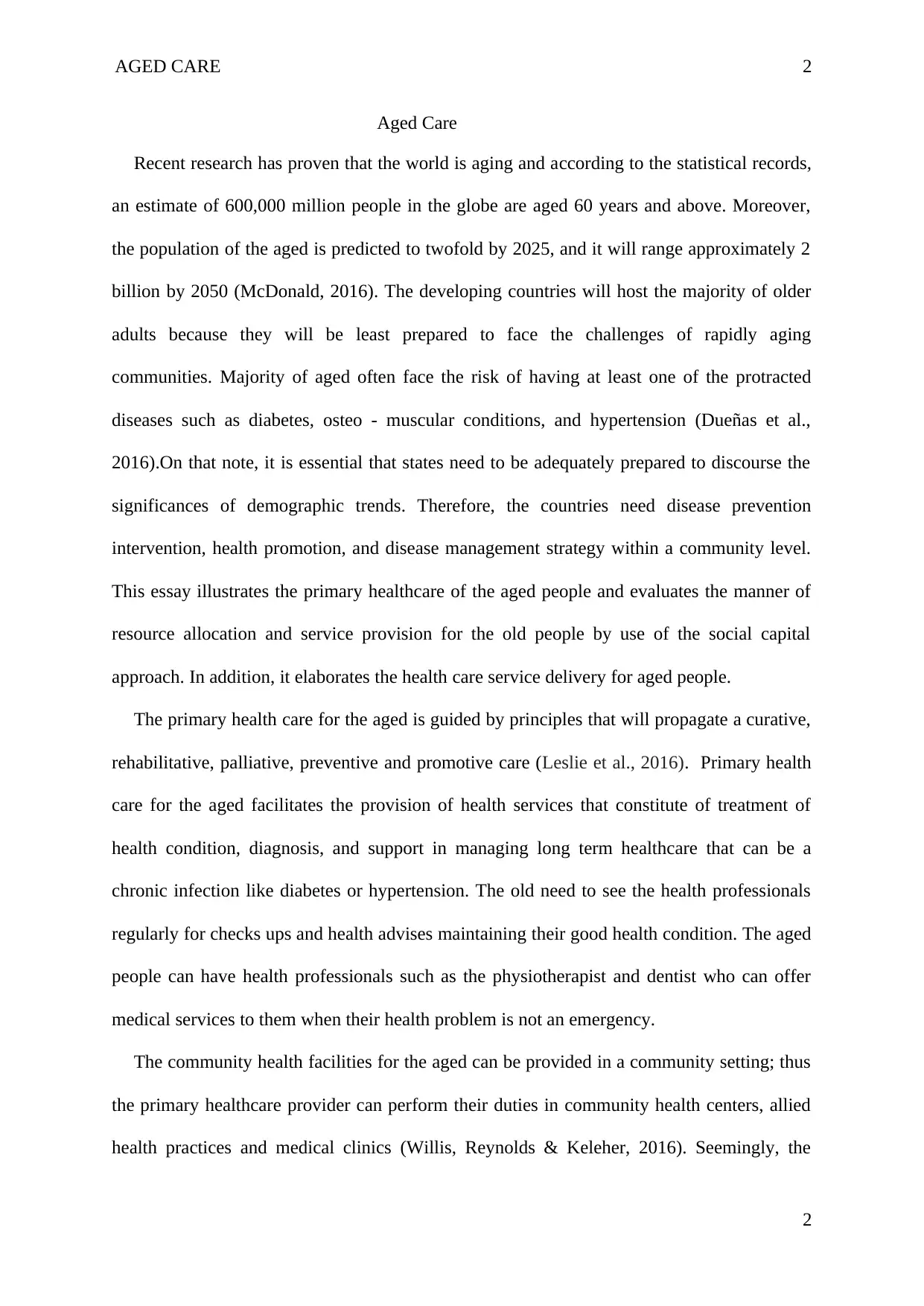
AGED CARE 2
Aged Care
Recent research has proven that the world is aging and according to the statistical records,
an estimate of 600,000 million people in the globe are aged 60 years and above. Moreover,
the population of the aged is predicted to twofold by 2025, and it will range approximately 2
billion by 2050 (McDonald, 2016). The developing countries will host the majority of older
adults because they will be least prepared to face the challenges of rapidly aging
communities. Majority of aged often face the risk of having at least one of the protracted
diseases such as diabetes, osteo - muscular conditions, and hypertension (Dueñas et al.,
2016).On that note, it is essential that states need to be adequately prepared to discourse the
significances of demographic trends. Therefore, the countries need disease prevention
intervention, health promotion, and disease management strategy within a community level.
This essay illustrates the primary healthcare of the aged people and evaluates the manner of
resource allocation and service provision for the old people by use of the social capital
approach. In addition, it elaborates the health care service delivery for aged people.
The primary health care for the aged is guided by principles that will propagate a curative,
rehabilitative, palliative, preventive and promotive care (Leslie et al., 2016). Primary health
care for the aged facilitates the provision of health services that constitute of treatment of
health condition, diagnosis, and support in managing long term healthcare that can be a
chronic infection like diabetes or hypertension. The old need to see the health professionals
regularly for checks ups and health advises maintaining their good health condition. The aged
people can have health professionals such as the physiotherapist and dentist who can offer
medical services to them when their health problem is not an emergency.
The community health facilities for the aged can be provided in a community setting; thus
the primary healthcare provider can perform their duties in community health centers, allied
health practices and medical clinics (Willis, Reynolds & Keleher, 2016). Seemingly, the
2
Aged Care
Recent research has proven that the world is aging and according to the statistical records,
an estimate of 600,000 million people in the globe are aged 60 years and above. Moreover,
the population of the aged is predicted to twofold by 2025, and it will range approximately 2
billion by 2050 (McDonald, 2016). The developing countries will host the majority of older
adults because they will be least prepared to face the challenges of rapidly aging
communities. Majority of aged often face the risk of having at least one of the protracted
diseases such as diabetes, osteo - muscular conditions, and hypertension (Dueñas et al.,
2016).On that note, it is essential that states need to be adequately prepared to discourse the
significances of demographic trends. Therefore, the countries need disease prevention
intervention, health promotion, and disease management strategy within a community level.
This essay illustrates the primary healthcare of the aged people and evaluates the manner of
resource allocation and service provision for the old people by use of the social capital
approach. In addition, it elaborates the health care service delivery for aged people.
The primary health care for the aged is guided by principles that will propagate a curative,
rehabilitative, palliative, preventive and promotive care (Leslie et al., 2016). Primary health
care for the aged facilitates the provision of health services that constitute of treatment of
health condition, diagnosis, and support in managing long term healthcare that can be a
chronic infection like diabetes or hypertension. The old need to see the health professionals
regularly for checks ups and health advises maintaining their good health condition. The aged
people can have health professionals such as the physiotherapist and dentist who can offer
medical services to them when their health problem is not an emergency.
The community health facilities for the aged can be provided in a community setting; thus
the primary healthcare provider can perform their duties in community health centers, allied
health practices and medical clinics (Willis, Reynolds & Keleher, 2016). Seemingly, the
2
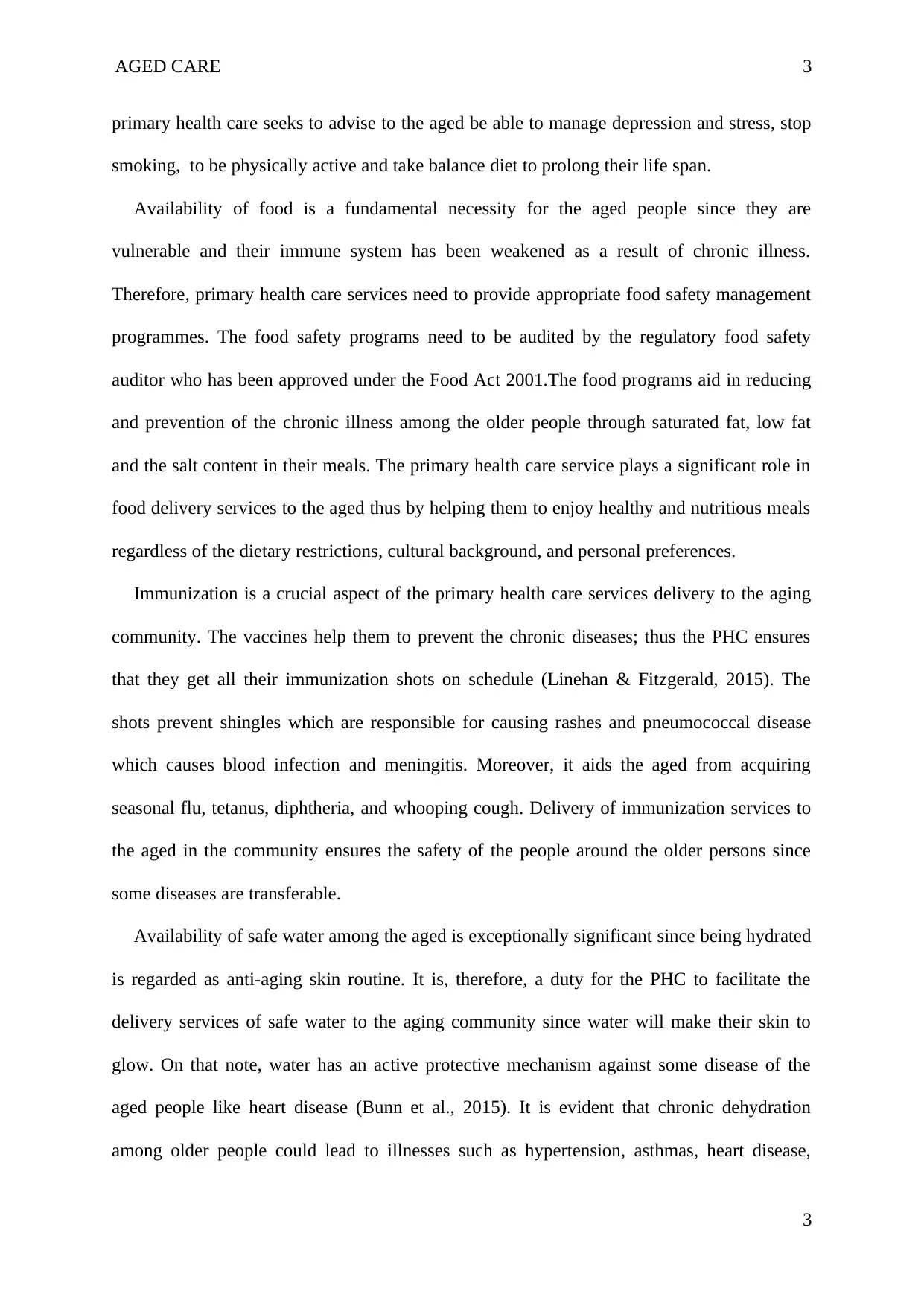
AGED CARE 3
primary health care seeks to advise to the aged be able to manage depression and stress, stop
smoking, to be physically active and take balance diet to prolong their life span.
Availability of food is a fundamental necessity for the aged people since they are
vulnerable and their immune system has been weakened as a result of chronic illness.
Therefore, primary health care services need to provide appropriate food safety management
programmes. The food safety programs need to be audited by the regulatory food safety
auditor who has been approved under the Food Act 2001.The food programs aid in reducing
and prevention of the chronic illness among the older people through saturated fat, low fat
and the salt content in their meals. The primary health care service plays a significant role in
food delivery services to the aged thus by helping them to enjoy healthy and nutritious meals
regardless of the dietary restrictions, cultural background, and personal preferences.
Immunization is a crucial aspect of the primary health care services delivery to the aging
community. The vaccines help them to prevent the chronic diseases; thus the PHC ensures
that they get all their immunization shots on schedule (Linehan & Fitzgerald, 2015). The
shots prevent shingles which are responsible for causing rashes and pneumococcal disease
which causes blood infection and meningitis. Moreover, it aids the aged from acquiring
seasonal flu, tetanus, diphtheria, and whooping cough. Delivery of immunization services to
the aged in the community ensures the safety of the people around the older persons since
some diseases are transferable.
Availability of safe water among the aged is exceptionally significant since being hydrated
is regarded as anti-aging skin routine. It is, therefore, a duty for the PHC to facilitate the
delivery services of safe water to the aging community since water will make their skin to
glow. On that note, water has an active protective mechanism against some disease of the
aged people like heart disease (Bunn et al., 2015). It is evident that chronic dehydration
among older people could lead to illnesses such as hypertension, asthmas, heart disease,
3
primary health care seeks to advise to the aged be able to manage depression and stress, stop
smoking, to be physically active and take balance diet to prolong their life span.
Availability of food is a fundamental necessity for the aged people since they are
vulnerable and their immune system has been weakened as a result of chronic illness.
Therefore, primary health care services need to provide appropriate food safety management
programmes. The food safety programs need to be audited by the regulatory food safety
auditor who has been approved under the Food Act 2001.The food programs aid in reducing
and prevention of the chronic illness among the older people through saturated fat, low fat
and the salt content in their meals. The primary health care service plays a significant role in
food delivery services to the aged thus by helping them to enjoy healthy and nutritious meals
regardless of the dietary restrictions, cultural background, and personal preferences.
Immunization is a crucial aspect of the primary health care services delivery to the aging
community. The vaccines help them to prevent the chronic diseases; thus the PHC ensures
that they get all their immunization shots on schedule (Linehan & Fitzgerald, 2015). The
shots prevent shingles which are responsible for causing rashes and pneumococcal disease
which causes blood infection and meningitis. Moreover, it aids the aged from acquiring
seasonal flu, tetanus, diphtheria, and whooping cough. Delivery of immunization services to
the aged in the community ensures the safety of the people around the older persons since
some diseases are transferable.
Availability of safe water among the aged is exceptionally significant since being hydrated
is regarded as anti-aging skin routine. It is, therefore, a duty for the PHC to facilitate the
delivery services of safe water to the aging community since water will make their skin to
glow. On that note, water has an active protective mechanism against some disease of the
aged people like heart disease (Bunn et al., 2015). It is evident that chronic dehydration
among older people could lead to illnesses such as hypertension, asthmas, heart disease,
3
⊘ This is a preview!⊘
Do you want full access?
Subscribe today to unlock all pages.

Trusted by 1+ million students worldwide
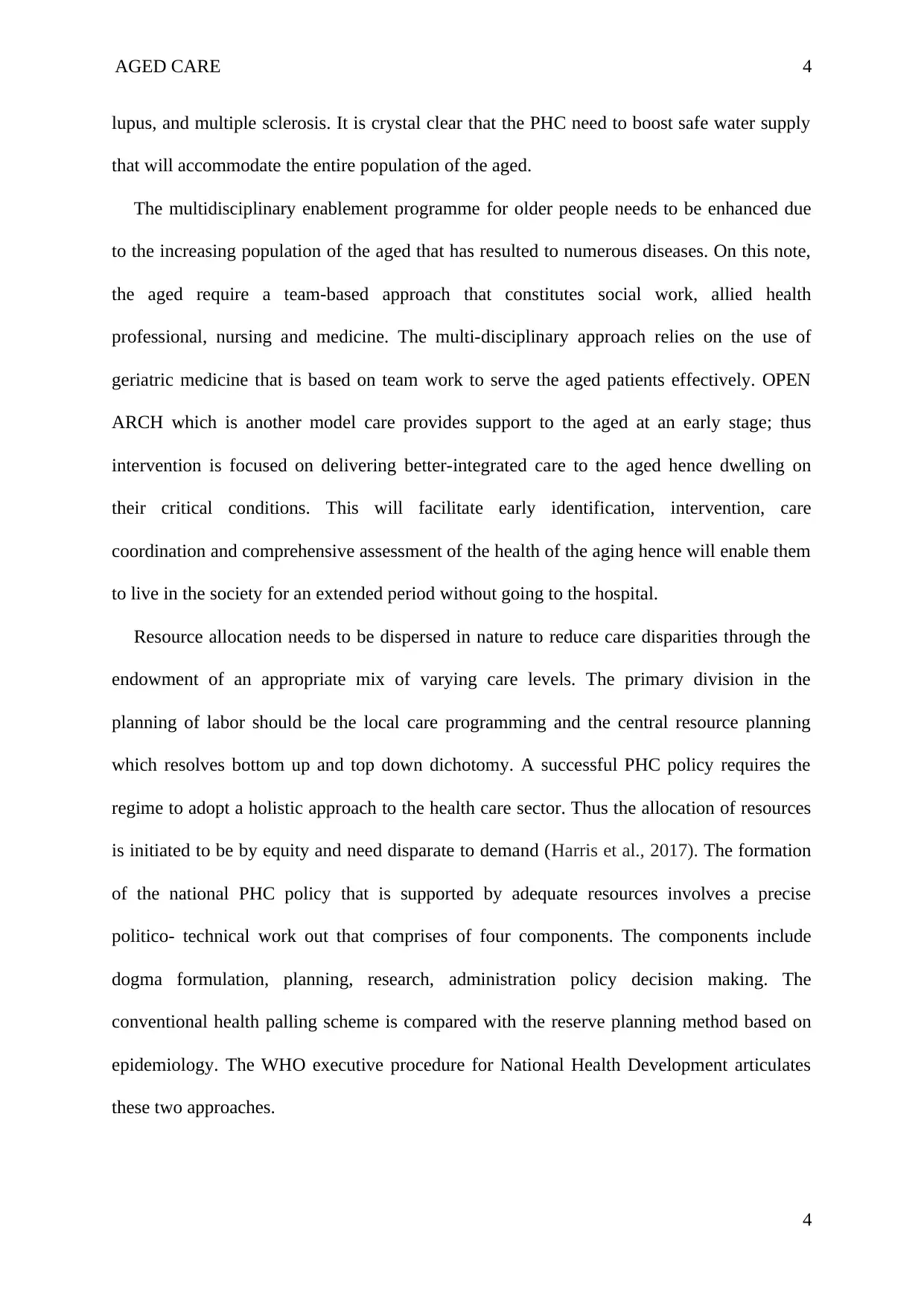
AGED CARE 4
lupus, and multiple sclerosis. It is crystal clear that the PHC need to boost safe water supply
that will accommodate the entire population of the aged.
The multidisciplinary enablement programme for older people needs to be enhanced due
to the increasing population of the aged that has resulted to numerous diseases. On this note,
the aged require a team-based approach that constitutes social work, allied health
professional, nursing and medicine. The multi-disciplinary approach relies on the use of
geriatric medicine that is based on team work to serve the aged patients effectively. OPEN
ARCH which is another model care provides support to the aged at an early stage; thus
intervention is focused on delivering better-integrated care to the aged hence dwelling on
their critical conditions. This will facilitate early identification, intervention, care
coordination and comprehensive assessment of the health of the aging hence will enable them
to live in the society for an extended period without going to the hospital.
Resource allocation needs to be dispersed in nature to reduce care disparities through the
endowment of an appropriate mix of varying care levels. The primary division in the
planning of labor should be the local care programming and the central resource planning
which resolves bottom up and top down dichotomy. A successful PHC policy requires the
regime to adopt a holistic approach to the health care sector. Thus the allocation of resources
is initiated to be by equity and need disparate to demand (Harris et al., 2017). The formation
of the national PHC policy that is supported by adequate resources involves a precise
politico- technical work out that comprises of four components. The components include
dogma formulation, planning, research, administration policy decision making. The
conventional health palling scheme is compared with the reserve planning method based on
epidemiology. The WHO executive procedure for National Health Development articulates
these two approaches.
4
lupus, and multiple sclerosis. It is crystal clear that the PHC need to boost safe water supply
that will accommodate the entire population of the aged.
The multidisciplinary enablement programme for older people needs to be enhanced due
to the increasing population of the aged that has resulted to numerous diseases. On this note,
the aged require a team-based approach that constitutes social work, allied health
professional, nursing and medicine. The multi-disciplinary approach relies on the use of
geriatric medicine that is based on team work to serve the aged patients effectively. OPEN
ARCH which is another model care provides support to the aged at an early stage; thus
intervention is focused on delivering better-integrated care to the aged hence dwelling on
their critical conditions. This will facilitate early identification, intervention, care
coordination and comprehensive assessment of the health of the aging hence will enable them
to live in the society for an extended period without going to the hospital.
Resource allocation needs to be dispersed in nature to reduce care disparities through the
endowment of an appropriate mix of varying care levels. The primary division in the
planning of labor should be the local care programming and the central resource planning
which resolves bottom up and top down dichotomy. A successful PHC policy requires the
regime to adopt a holistic approach to the health care sector. Thus the allocation of resources
is initiated to be by equity and need disparate to demand (Harris et al., 2017). The formation
of the national PHC policy that is supported by adequate resources involves a precise
politico- technical work out that comprises of four components. The components include
dogma formulation, planning, research, administration policy decision making. The
conventional health palling scheme is compared with the reserve planning method based on
epidemiology. The WHO executive procedure for National Health Development articulates
these two approaches.
4
Paraphrase This Document
Need a fresh take? Get an instant paraphrase of this document with our AI Paraphraser
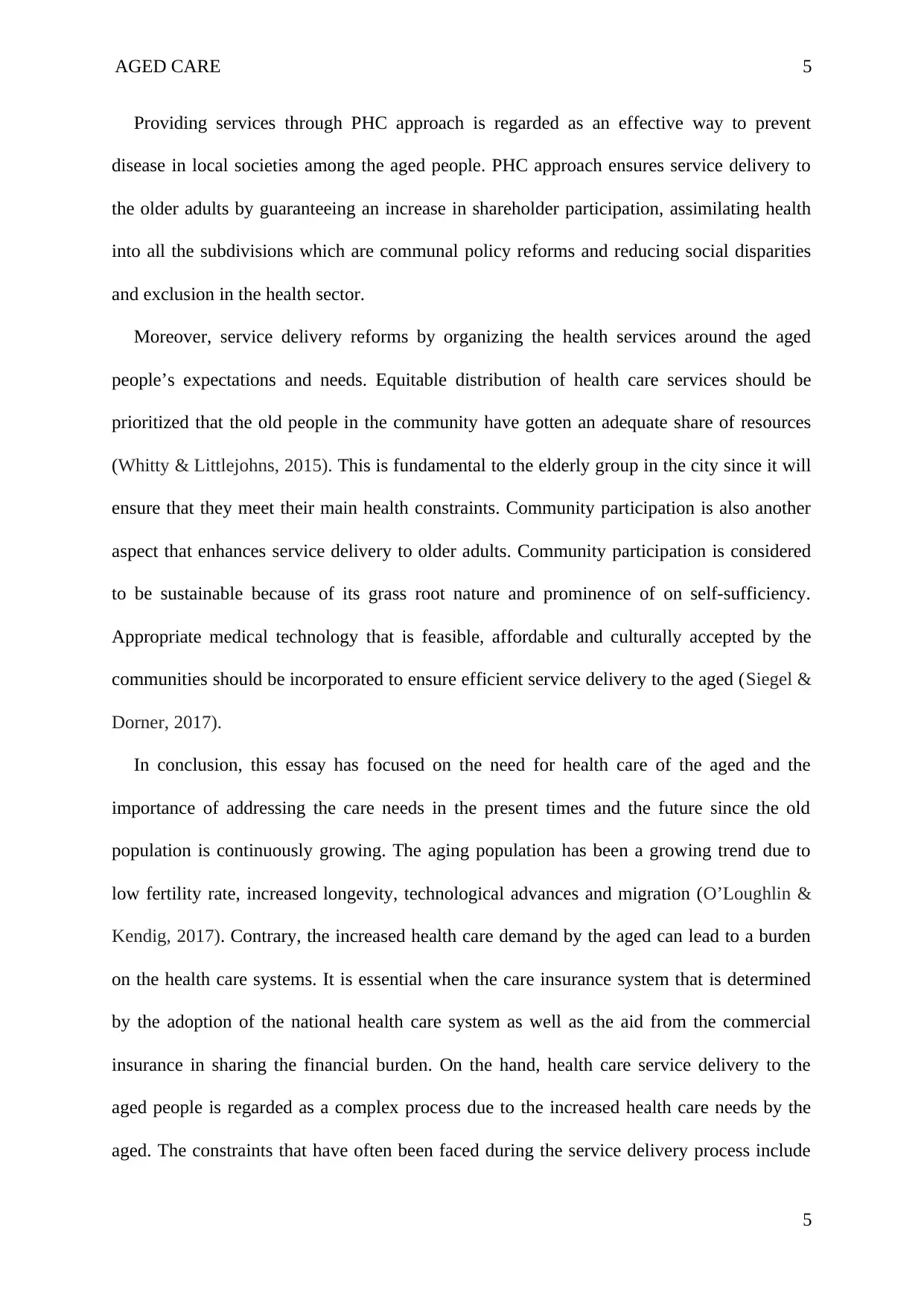
AGED CARE 5
Providing services through PHC approach is regarded as an effective way to prevent
disease in local societies among the aged people. PHC approach ensures service delivery to
the older adults by guaranteeing an increase in shareholder participation, assimilating health
into all the subdivisions which are communal policy reforms and reducing social disparities
and exclusion in the health sector.
Moreover, service delivery reforms by organizing the health services around the aged
people’s expectations and needs. Equitable distribution of health care services should be
prioritized that the old people in the community have gotten an adequate share of resources
(Whitty & Littlejohns, 2015). This is fundamental to the elderly group in the city since it will
ensure that they meet their main health constraints. Community participation is also another
aspect that enhances service delivery to older adults. Community participation is considered
to be sustainable because of its grass root nature and prominence of on self-sufficiency.
Appropriate medical technology that is feasible, affordable and culturally accepted by the
communities should be incorporated to ensure efficient service delivery to the aged (Siegel &
Dorner, 2017).
In conclusion, this essay has focused on the need for health care of the aged and the
importance of addressing the care needs in the present times and the future since the old
population is continuously growing. The aging population has been a growing trend due to
low fertility rate, increased longevity, technological advances and migration (O’Loughlin &
Kendig, 2017). Contrary, the increased health care demand by the aged can lead to a burden
on the health care systems. It is essential when the care insurance system that is determined
by the adoption of the national health care system as well as the aid from the commercial
insurance in sharing the financial burden. On the hand, health care service delivery to the
aged people is regarded as a complex process due to the increased health care needs by the
aged. The constraints that have often been faced during the service delivery process include
5
Providing services through PHC approach is regarded as an effective way to prevent
disease in local societies among the aged people. PHC approach ensures service delivery to
the older adults by guaranteeing an increase in shareholder participation, assimilating health
into all the subdivisions which are communal policy reforms and reducing social disparities
and exclusion in the health sector.
Moreover, service delivery reforms by organizing the health services around the aged
people’s expectations and needs. Equitable distribution of health care services should be
prioritized that the old people in the community have gotten an adequate share of resources
(Whitty & Littlejohns, 2015). This is fundamental to the elderly group in the city since it will
ensure that they meet their main health constraints. Community participation is also another
aspect that enhances service delivery to older adults. Community participation is considered
to be sustainable because of its grass root nature and prominence of on self-sufficiency.
Appropriate medical technology that is feasible, affordable and culturally accepted by the
communities should be incorporated to ensure efficient service delivery to the aged (Siegel &
Dorner, 2017).
In conclusion, this essay has focused on the need for health care of the aged and the
importance of addressing the care needs in the present times and the future since the old
population is continuously growing. The aging population has been a growing trend due to
low fertility rate, increased longevity, technological advances and migration (O’Loughlin &
Kendig, 2017). Contrary, the increased health care demand by the aged can lead to a burden
on the health care systems. It is essential when the care insurance system that is determined
by the adoption of the national health care system as well as the aid from the commercial
insurance in sharing the financial burden. On the hand, health care service delivery to the
aged people is regarded as a complex process due to the increased health care needs by the
aged. The constraints that have often been faced during the service delivery process include
5
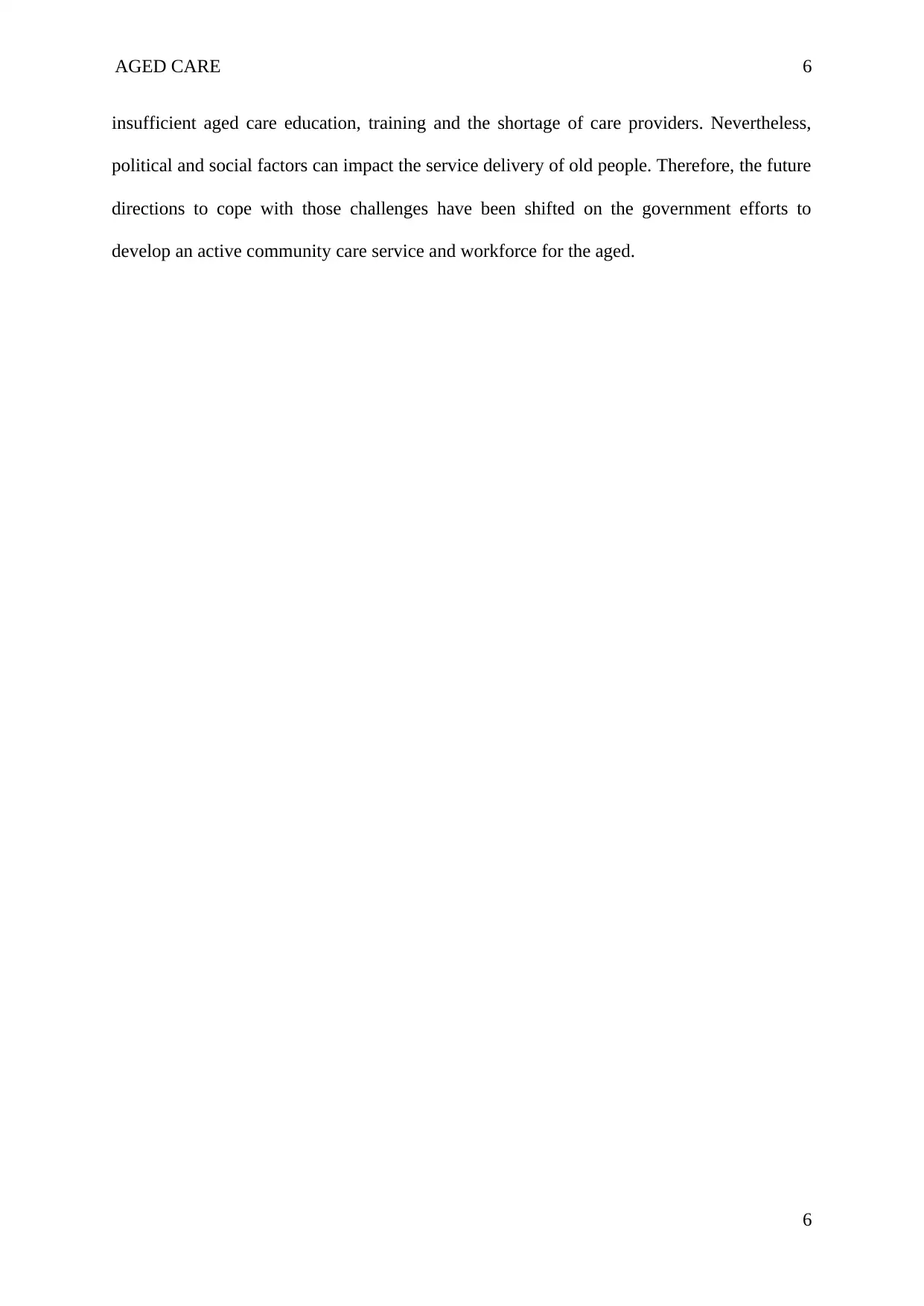
AGED CARE 6
insufficient aged care education, training and the shortage of care providers. Nevertheless,
political and social factors can impact the service delivery of old people. Therefore, the future
directions to cope with those challenges have been shifted on the government efforts to
develop an active community care service and workforce for the aged.
6
insufficient aged care education, training and the shortage of care providers. Nevertheless,
political and social factors can impact the service delivery of old people. Therefore, the future
directions to cope with those challenges have been shifted on the government efforts to
develop an active community care service and workforce for the aged.
6
⊘ This is a preview!⊘
Do you want full access?
Subscribe today to unlock all pages.

Trusted by 1+ million students worldwide
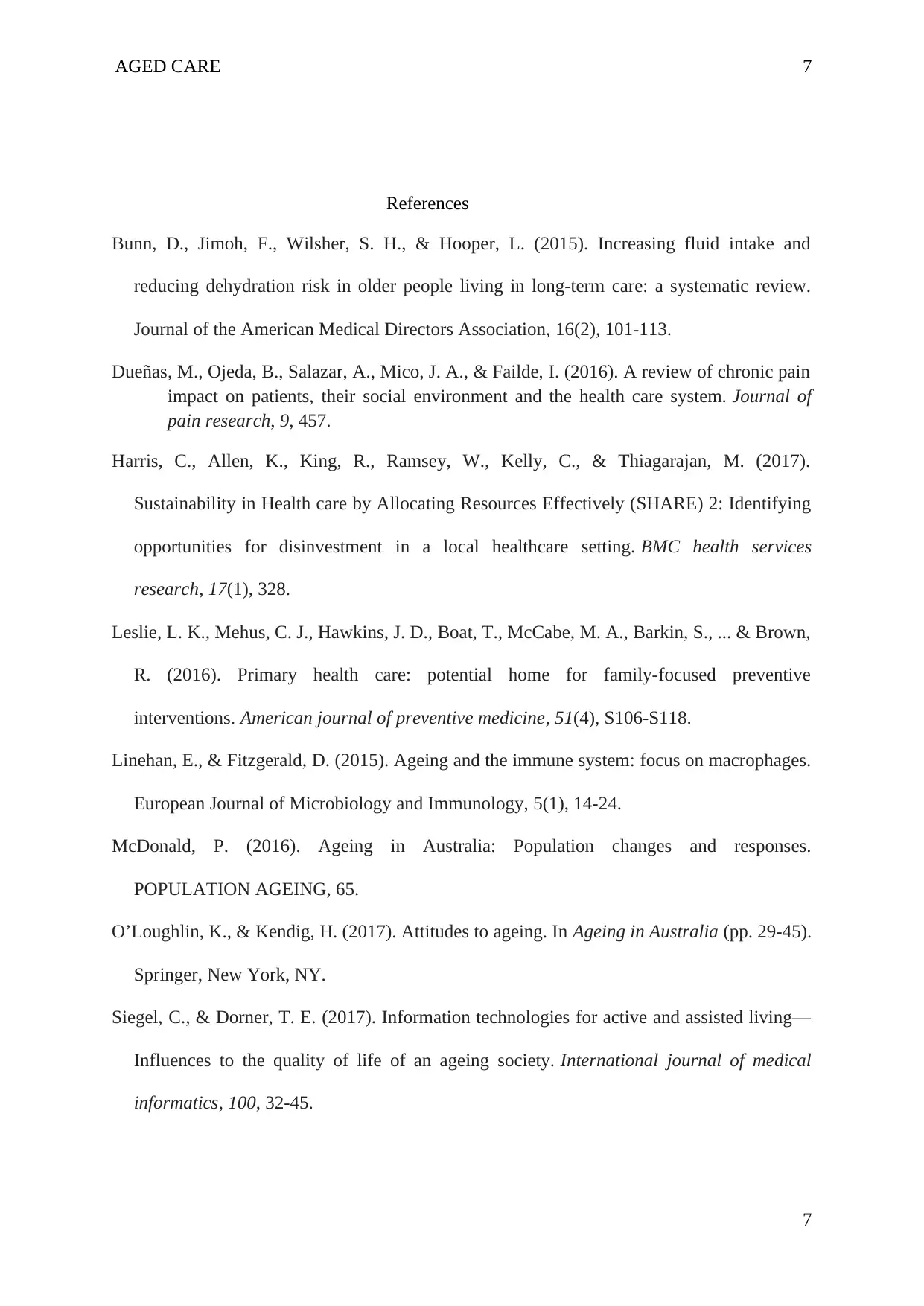
AGED CARE 7
References
Bunn, D., Jimoh, F., Wilsher, S. H., & Hooper, L. (2015). Increasing fluid intake and
reducing dehydration risk in older people living in long-term care: a systematic review.
Journal of the American Medical Directors Association, 16(2), 101-113.
Dueñas, M., Ojeda, B., Salazar, A., Mico, J. A., & Failde, I. (2016). A review of chronic pain
impact on patients, their social environment and the health care system. Journal of
pain research, 9, 457.
Harris, C., Allen, K., King, R., Ramsey, W., Kelly, C., & Thiagarajan, M. (2017).
Sustainability in Health care by Allocating Resources Effectively (SHARE) 2: Identifying
opportunities for disinvestment in a local healthcare setting. BMC health services
research, 17(1), 328.
Leslie, L. K., Mehus, C. J., Hawkins, J. D., Boat, T., McCabe, M. A., Barkin, S., ... & Brown,
R. (2016). Primary health care: potential home for family-focused preventive
interventions. American journal of preventive medicine, 51(4), S106-S118.
Linehan, E., & Fitzgerald, D. (2015). Ageing and the immune system: focus on macrophages.
European Journal of Microbiology and Immunology, 5(1), 14-24.
McDonald, P. (2016). Ageing in Australia: Population changes and responses.
POPULATION AGEING, 65.
O’Loughlin, K., & Kendig, H. (2017). Attitudes to ageing. In Ageing in Australia (pp. 29-45).
Springer, New York, NY.
Siegel, C., & Dorner, T. E. (2017). Information technologies for active and assisted living—
Influences to the quality of life of an ageing society. International journal of medical
informatics, 100, 32-45.
7
References
Bunn, D., Jimoh, F., Wilsher, S. H., & Hooper, L. (2015). Increasing fluid intake and
reducing dehydration risk in older people living in long-term care: a systematic review.
Journal of the American Medical Directors Association, 16(2), 101-113.
Dueñas, M., Ojeda, B., Salazar, A., Mico, J. A., & Failde, I. (2016). A review of chronic pain
impact on patients, their social environment and the health care system. Journal of
pain research, 9, 457.
Harris, C., Allen, K., King, R., Ramsey, W., Kelly, C., & Thiagarajan, M. (2017).
Sustainability in Health care by Allocating Resources Effectively (SHARE) 2: Identifying
opportunities for disinvestment in a local healthcare setting. BMC health services
research, 17(1), 328.
Leslie, L. K., Mehus, C. J., Hawkins, J. D., Boat, T., McCabe, M. A., Barkin, S., ... & Brown,
R. (2016). Primary health care: potential home for family-focused preventive
interventions. American journal of preventive medicine, 51(4), S106-S118.
Linehan, E., & Fitzgerald, D. (2015). Ageing and the immune system: focus on macrophages.
European Journal of Microbiology and Immunology, 5(1), 14-24.
McDonald, P. (2016). Ageing in Australia: Population changes and responses.
POPULATION AGEING, 65.
O’Loughlin, K., & Kendig, H. (2017). Attitudes to ageing. In Ageing in Australia (pp. 29-45).
Springer, New York, NY.
Siegel, C., & Dorner, T. E. (2017). Information technologies for active and assisted living—
Influences to the quality of life of an ageing society. International journal of medical
informatics, 100, 32-45.
7
Paraphrase This Document
Need a fresh take? Get an instant paraphrase of this document with our AI Paraphraser
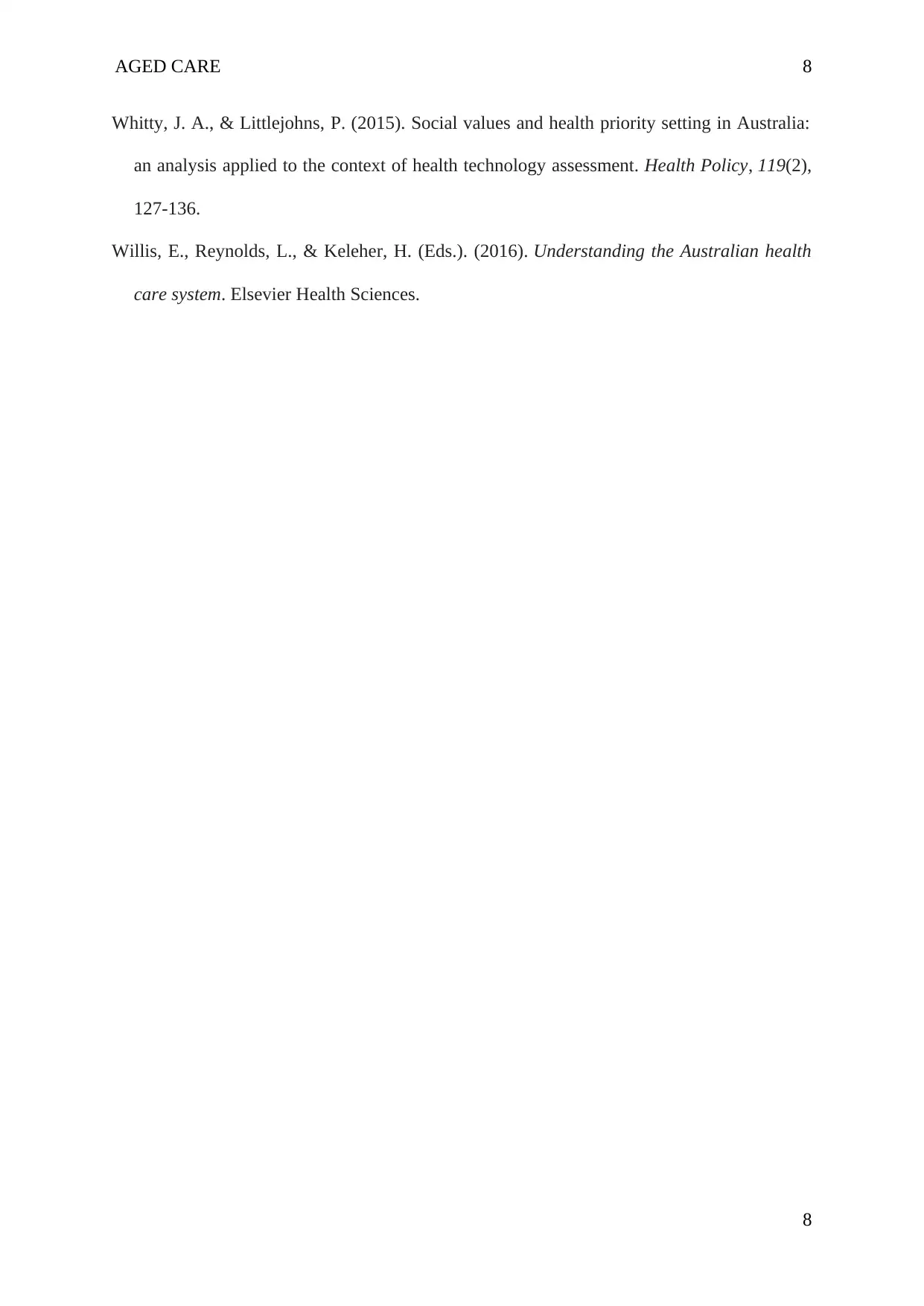
AGED CARE 8
Whitty, J. A., & Littlejohns, P. (2015). Social values and health priority setting in Australia:
an analysis applied to the context of health technology assessment. Health Policy, 119(2),
127-136.
Willis, E., Reynolds, L., & Keleher, H. (Eds.). (2016). Understanding the Australian health
care system. Elsevier Health Sciences.
8
Whitty, J. A., & Littlejohns, P. (2015). Social values and health priority setting in Australia:
an analysis applied to the context of health technology assessment. Health Policy, 119(2),
127-136.
Willis, E., Reynolds, L., & Keleher, H. (Eds.). (2016). Understanding the Australian health
care system. Elsevier Health Sciences.
8
1 out of 8
Related Documents
Your All-in-One AI-Powered Toolkit for Academic Success.
+13062052269
info@desklib.com
Available 24*7 on WhatsApp / Email
![[object Object]](/_next/static/media/star-bottom.7253800d.svg)
Unlock your academic potential
Copyright © 2020–2025 A2Z Services. All Rights Reserved. Developed and managed by ZUCOL.





